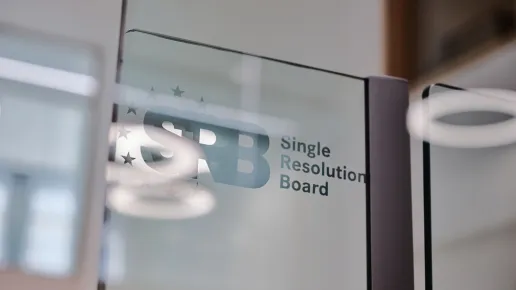The European crisis management framework is a strong, flexible framework that is well-designed to manage bank failure. However, work remains to be done to enhance the framework. I will focus on two key issues: ensuring we have the options needed to manage the failures of small and medium-sized banks, and ensuring we have a harmonised framework across the Banking Union for banks of all sizes.
While there is broad support for widening the use of resolution tools to cover medium-sized banks, how to finance those tools remains more controversial.
The European framework is built on the assumption that banks within the scope of resolution are able to build up loss-absorbing capacity, typically through market issuance of instruments eligible to meet the MREL requirement, which can be used in resolution. To address concerns of moral hazard, strict conditions are applied for access to additional financing (both for deposit guarantee scheme (“DGS”) funds and the Single Resolution Fund). Where such conditions cannot be met, this raises the risk there will be inadequate loss-absorbing capacity to support a resolution at the level of the firm, but that it will also not be possible to access additional funds. This could pose risks to the SRB’s objectives of preserving financial stability and protecting depositors. This may incentivise finding ways to circumvent the framework.
On its side, the SRB stands ready to incorporate more banks under the scope of resolution, but this must go alongside effective funding arrangements. Banks’ shareholders and creditors will always be the first to bear losses, but the question may be asked whether it is desirable to bail in deposits in some cases (e.g. where it undermines financial stability or depletes the franchise value). In the absence of a European Deposit Insurance Scheme, DGS funds can still play a key role under a robust and harmonised “least cost test” and with a clear market exit strategy. However, the current use of DGS funds in resolution is extremely restricted due to their priority afforded to covered deposits, even relative to other deposits, in the creditor hierarchy. Moving to a general depositor preference would allow DGSs to play a greater role in the financial safety net. DGSs could step in in lieu of deposits, once shareholders and creditors have been bailed-in and before accessing SRF funds, where needed. This would put in place a clear and predictable framework that would enable DGSs to support the Resolution Authority in protecting all depositors, though, of course, only where needed in the public interest.
Importantly, DGS funds must only be used in resolution when it is less costly than the counterfactual payout to depositors. Given the need for immediate pay-out of the whole deposit book in such a scenario, past cases show how costly pay-out can be for a DGS, even for smaller banks. The key difference would be that changing DGSs’ position in the creditor hierarchy would increase its potential losses in a counterfactual insolvency, and, as a result, its possible role in supporting a resolution scheme. As noted, this should only be possible to support market exit, ensuring that industry funds are only used to support the efficient removal of market actors and minimise value destruction.
The second issue concerns the wideranging set of approaches across Member States for the management of small bank failures. This leads to an uneven playing field, prevents predictability across the Banking Union and hinders its integration. The current framework allows for significant national discretion, particularly as regards the treatment of creditors and the possibilities to use DGS funds: this can lead to a wide divergence in the outcomes across Member States.
In this context, the Banking Union urgently needs a more harmonised creditor hierarchy and a single set of criteria that would apply for the use of DGS funds, however those funds are used (preventive measures prior to failure, alternative measures in the context of insolvency, or to support resolution). A crucial element relates to the least cost test for which a robust framework is critical, aligning its calculation across both Member States and the different possible interventions. Taken together with the above measures to expand access to DGS funds in resolution, this would remove options that circumvent the framework or lead to the use of public funds, without increasing risks to financial stability or depositors.
Coming to a conclusion, European DGSs are a key part of the financial safety net, and this role could be further enhanced by revising the crisis management and deposit insurance framework. Expanding the scope of resolution without proper funding presents a clear risk that resolution authorities will not be able to deliver their mandate. Co-legislators and the industry should beware of leaving gaps in the framework that undermine predictability, financial stability and, ultimately, Banking Union integration.
Contact our communications team
Recent news

The SRB recently published two important documents clarifying its expectations of banks regarding operational resolvability: the Operational guidance...

The body responsible for managing banks in crisis in Europe is celebrating its 10th anniversary and claims that Popular's 2017 resolution has been...

In last June, Parliament and Council have clinched a political deal that is applicable to all the EU member states, and which can be seen as a step...



